
IMMAGINI RELATIVE AI MIEI MESSAGGI
per il FORUM FILATELIA e FRANCOBOLLI pagina 163
FORUM CONTINUA 163: Qui parleremo di francobolli meravigliosi, di classici e costosi francobolli che molti di noi vorrebbero possedere anche se magari non fanno parte dell'area che raccolgono normalmente. Infatti abbiamo cover con francobolli LOCALI di tutto il mondo, più buste aeree particolari ed un po' di posta dall'Antartide!
Ringrazio anticipatamente chi mi ha permesso di avere queste immagini per presentarvele.
Ma prima vi voglio mostrare una cover (probabilmente autentica) mostrata come barzelletta dal sito "bastardididentro", che a richiesta manda una e-mail con delle barzellette (di solito molto carine ogni giorno). Iscrivetevi, se vi fa piacere, al www.bastardidentro.it inserendo la vostra e-mail nell'apposito spazio sul lato sinistro della loro homepage...
Ecco la barzelletta:
Al telefono:
- Dove la devo spedire?
- Strada Statale 195, Località Sailletta
- ...e mi scusi, come si scrive Sailletta??
-
Ora glielo detto, pronto a scrivere?
- Si, mi dica... (Guarda l'immagine:)

![]()
![]()
![]()
![]()
![]()
![]()
![]()
![]()
Dopo che ci siamo fatti una bella risata vediamo queste GEMME della filatelia. Però per creare un po' di suspance vi chiedo due cose,
-1) individuare di quale francobollo si tratti, cioè di quale luogo o nazione,
-2) dare una stima personale a ciascuna di queste cover o francobollo.
Poi io vi dirò da dove provengono e qualche informazione in più. Su ogni lotto metterò prima il vostro commento e poi in corsivo la descrizione presa dal catalogo d'asta (prezzi dell'asta in sterline):
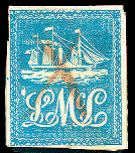
lotto 1
Paolo Pozzo68 dice:
Lotto
n. 1 e lotto n. 7: Lady Mcleod
Trinidad emise il suo primo francobollo nel 1851, ma prima di allora già
esisteva un servizio postale che era assicurato dal battello "Lady Mcleod"
(dal nome della moglie del Governatore di Trinidad). Il trasporto della posta
veniva effettuato tra San Fernando e Porto di Spagna.
Il servizio veniva pagato attraverso un FB blu che raffigurava il battello e le
iniziali del suo nome "LML". L'annullo era fatto con un segno di penna
posto a croce sul FB.
Il valore è notevole ![]() , dalle ricerche che ho fatto dovrebbe variare dai 10 mila euro per un esemplare
usato agli oltre 20 mila per uno su busta.
, dalle ricerche che ho fatto dovrebbe variare dai 10 mila euro per un esemplare
usato agli oltre 20 mila per uno su busta.
TRINIDAD’S “LADY McLEOD” - the first stamp issued in a British Colony, 1847 (5c.)Blue, clear to generous margins all around and neat pen cross cancel, a premium example, cert. R.P.S. (1946), fine, ex Amundsen. Note: the “Lady McLeod” adhesive was issued in April while the first , “Post Office” issue of Mauritius (the first governmental issue of any British Colony) was issued in September.. .................................. E £2,500

lotto 2

lotto 3
Fiore:
Lotto
3: Fresno-San Francisco bycicle mail. Molte attinenze con il lotto 4, compreso
il periodo (qui mi sento più sicuro a scrivere 1894).
Servizio istituito nel 1894 a seguito di uno sciopero ferroviario (che impediva
quindi l'inoltro della corrispondenza), durò... quanto lo sciopero stesso,
ovvero una decina di giorni. Lettere inoltrate: qualche centinaio.
Sul valore vado più cauto: 1000 Euro.
USA: Fresno & San Francisco Bicycle Mail Route, first issue (spelling error “Fransisco”) tied by faint bars cancel and San Francisco duplex to USA 2c. entire, with elaborate h.s. pictorial ad for the service on reverse dated July 10, 1894, San Francisco cancels dated the 12th, scarce and very fine (Scott 12L1) .................... E £500
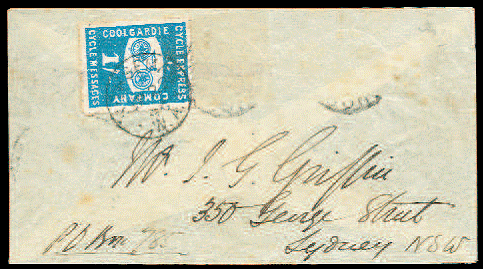
lotto 4
Fiore:
Il
lotto 4: Coolgardie Cycle Express, compagnia australiana di fine '800 (sparo:
1894-1896 ![]() ) che, come si evince dal nome, provvedeva all'inoltro della corrispondenza via
bicicletta.
) che, come si evince dal nome, provvedeva all'inoltro della corrispondenza via
bicicletta.
Valore? Qui è dove sono in assoluto più ignorante, ma non solo su questi pezzi
quasi unici... sicuramente alto, visto che viaggiate ne saranno rimaste poche,
in giro. Devo tentare? 4000 Euro.
Coolgardie 1894 issue, three items with 1/- or 2/- “Bicycles” tied by two-line violet Coolgardie cancels, incl. 1896 outbound cover (to Sydney, other franking missing) with 1/- tied by Noresman, W.A. c.d.s. and with Esperance, W.A. transit and Sydney, N.S.W. b.s., plus inbound front with with 1/- “Bicycle” and S.A. 2d. tied, also 2/- similarly tied to 1899 inward cover via Coolgardie and with W.A. 2d. Swan tied at Albany, W.A. (with Coolgardie postal b.s. and elaborate oval cachet of the proprietor of the Bicycle Service on reverse), an extremely rare offering though in somewhat mixed condition as invariably found. .................................... E £5,000
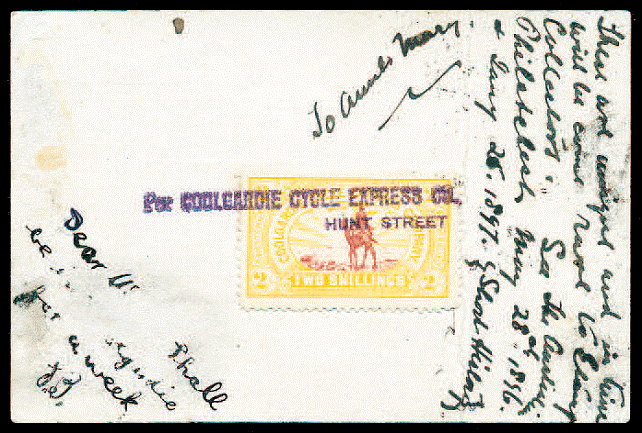
lotto 5
Fiore:
Lotto
5: vedi lotto 4. Valore: la cover mi sembra più significativa della precedente,
la pago ( ![]()
![]()
![]() ) 1.000 Euro in più.
) 1.000 Euro in più.
Questa è posta "via cammello", usati oltre che la bicicletta (N.d.R).
1896 3rd Issue (showing camel & rider), 1897 advertising postcard for the enterprise with 2/- value tied to reverse by dark violet 2-line h.s., message states, “These are unique and in time will become rare to Stamp Collectors...” and addressed “To Aunt Mary,” an extremely scarce souvenir usage (stamps were in use per Hurt & Williams for “only about two days”), also complete unused set of three (part o.g.), card with crease and small scuff else fine.................................. E £1,500

set dei te bolli con cammello
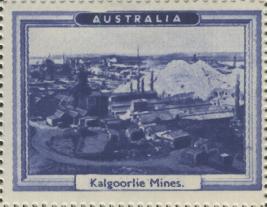
poster stamp delle miniere di Coolgardie (qui scritto Kalgoorlie)

lotto 6

lotto 7
Ppozzo68: stima cover 20.000 euro in su.
— 5c. “Lady McLeod” with margins all around save at bottom left, with customary pen cross, on folded letter (small repair at top centre) from Port of Spain to San Fernando written July 1, 1847, fine and attractive, certs. R.P.S. & B.P.A., ex Seybold (usual large h.s. on back) and van Dieten................................................ E £10,000

lotto 8
Butto là una lettura del lotto 8: lettera con il francobollo da 10 kr. verde (1867) della compagnia di navigazione danubiana DDSG.Allego una cenno storico sulla compagnia, tratto dall'ultimo catalogo d'asta Feldman (tenutasi a inizio ottobre) (stima della cover:
:
THE D.D.S.G STORY
These four initials used to be quite a popular acronym under the imperial
Habsburgs. From Metternich and the Rothschilds onwards it came to be
understood as a symbol of Austrian efficiency and of commercial penetration
into the Balkans and the Ottoman Empire.When the “pyroscaph” started
paddling on the most majestic waterway in Europe, the rival “steamhorse”
had not yet made its appearance. Within a few years, an entirely new approach
became possible when tackling the difficult transport problems in a region
where roads, security and regularity so far had been cruelly inadequate.
Astonishingly fast progress was made with regard to speed, reliability and
capacity of the DDSG ships on the Danube, which henceforth remained their
undisputed playing field for over one hundred years. The "First Imperial
Royal Privileged Steam Navigation Company" was founded on March 18, 1829,
on the initiative of two English shipbuilders. On the Clyde and the Hudson,
they had witnessed the economical advantages of installing steam engines on
barges and wooden hulls which were plying along coastal stretches and on
rivers, especially when going upstream. They acquired a 15 year privilege for
trading rights on the Danube, and in 1830 already made trial runs from Vienna,
upstream to Linz and downstream to Budapest. No less than the emperor himself
baptized their first steamer with his name: Franz I. By 1834, the D.S.G. fleet
counted already five units. The "Argo" had reached Galatz, while the
"Maria Dorothea" ventured out into the Black Sea and all the way to
Constantinople. By 1837, when the Lloyd Austriaco launched the "Arciduca
Ludovia" on its maiden trip from Triest, the D.S.G. were already
operating their postal services in most of the Levant ports. These paddle
steamers with sails were no longer afraid of maritime storms and considerable
distances. Besides Odessa, Saloniki, the Dardanelles and Smyrna, they went to
Beyrouth and even Jaffa, as documented by recently discovered postmarks. In
1845 the wind had changed. With the high operating costs of extensive fleets,
two major shipping companies under the same flag were unsustainable.
Bankruptcy loomed. After lengthy discussions involving the government, it was
decided to nominate the Lloyd Austriaco sole official postal agent in the
Mediterranean ports and to restrain the D.S.G. to the Danube. An additional
"D" (for Danube) was added to the original company name, meaning
that the D.D.S.G. schedule had to stop at Sulina on the Danube delta. Up to
1875, when the Austro-Hungarian Empire joined the U.P.U., the activities of
the D.D.S.G. with its 40 steamers and over 50 agencies between Ulm and the
Black Sea remained to be an exceptionally rich treasure trove for postal
historians. True, there is unsatisfactory documentation for the period of the
Crimean War, when the ships served as troop transports for the Austrian army
sent to occupy the Danubian Principalities. But the collector is easily
fascinated by the prephilatelic conflicts up to 1866, and after that by the
wealth of private issues and postmarks.Without authorization to handle foreign
mail, the D.D.S.G. agents rapidly developed imaginative means to accept and
transport such letters all the way from the delta (and even Odessa) to
Baziasch in Hungary, where the railway could take over. In 1878, after the
Congress of Berlin, the D.D.S.G. was forced to abandon all its mailing
functions to the official government posts of each of the countries involved.
From Alt-Orsova downstream the D.S.G. agencies were on Ottoman territory on
both sides of the Danube. The earliest postal material recorded bearing the
handstamp of a ship (1839) was from the MARIA DOROTHEA of the D.S.G., plying
between
Salonica and the Dardanelles.
DANUBE STEAM NAVIGATION CO. MAIL, 1867 folded letter with 17k. Red tied by blue Calafat (Romania) c.d.s. and sent to Braila, plus 1869 folded letter with 10k. Green tied by Sistov (Bulgaria) agent’s oval and sent to Orsova, fresh and fine ... E £300
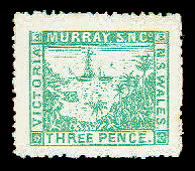
lotto 9
Fiore:
Lotto
9: Murray Steam Navigation Company, attiva in Australia; effettua trasporto di
posta tra (come si legge dal bollo stesso) Victoria e Nuovo Galles del Sud nel
1872.
Il bollo è nuovo, non viaggiato, lo paghiamo poco ( ![]() ): 300 Euro. (il dentello è molto raro! N.dR.)
): 300 Euro. (il dentello è molto raro! N.dR.)
MURRAY’S STEAM NAVIGATION CO. - 1869 (circa) unused set of 5 incl. both 1/2d. (inscribed “PENNY” or “PENCE”), faults (trivial to severe), very rare (Robson Lowe 2-5) .............................................................................................................. E £450
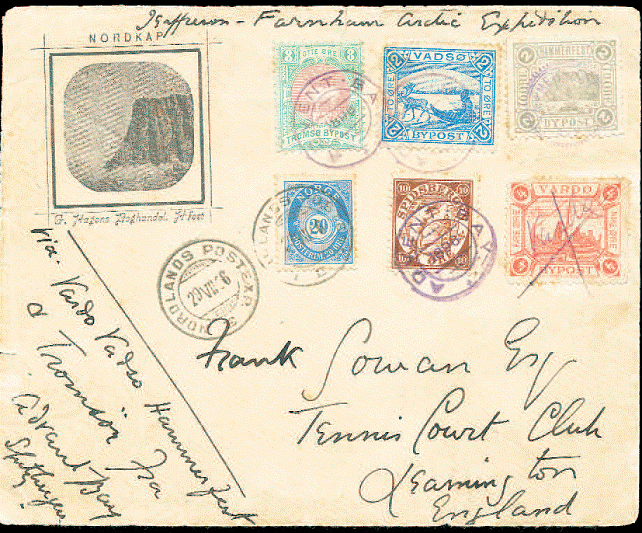
lotto 10
Fiore:
Lotto
10... ![]() ... ci provo:
... ci provo:
sono riconoscibili, oltre al bollo "comune" norvegese, 5 bolli locali
norvegesi. "Bypost" indica appunto la posta locale "in voga"
tanto in Norvegia quanto in Svezia tra il 1865 ed il 1900.
Ci sono tre municipalità nel Finnmark (Hammerfest, Vadso e Vardo), la regione
della Norvegia all'estremo nord molto vicino a Capo Nord, ed una leggermente più
a sud ( ![]() ), Tromso. Poi c'è il "local" delle Spitsbergen, che è una delle
Svalbard, le isole (che tuttora emettono "locals") nell'estremo nord
un po' "contese" dalla Russia (ma facenti parte del regno di
Norvegia).
), Tromso. Poi c'è il "local" delle Spitsbergen, che è una delle
Svalbard, le isole (che tuttora emettono "locals") nell'estremo nord
un po' "contese" dalla Russia (ma facenti parte del regno di
Norvegia).
Direi che, tutto sommato, qualcuno nel 1898 si è fatto un viaggio verso Capo
Nord e poi ha proseguito per le Svalbard, "raccogliendo" lungo la
strada bolli locali delle municipalità che toccava e facendo annullare il tutto
all'arrivo sulle Svalbard. La nota nell'angolo in basso a sinistra evidenzia
questo "ragionamento": "Via Vardo, Vadso, Hammerfest, Tromso fino
a Advent Bay, Spitsbergen".
Il bollo norvegese è servito evidentemente per la "spedizione" vera e
propria.
Bella cover, riassume un bel po' di "locals"! Però non so quanto la
si possa definire "rara". Boh, sparo: 1000 Euro anche per lei!
1896 JEAFFRESON-FARNHAM ARCTIC EXPEDITION, cacheted cover plus matching lettersheet (each showing “Nordkap”) written and signed by Jeaffreson from Amsterdam Island (80 degrees N. Lat.), cover franked by Norway 20o plus five diff. Bypost issues (Hammerfest, Spidsbergen, Tromso, Vadso and Vardo), most tied by Advent Bay, Hammerfest or 29 VII 96 Nordlands Post Exp. cancels (one by ms. “Vardo”), Aug. 4 English backstamp, odd short or toned perf. and trivial cover edge tears else fine and very scarce early Polar item .................................. E £750

lotto 11
Fiore:
Parliamo
del lotto 11: bollo neozelandese soprastampato nel 1908 in occasione di una
spedizione di Shackleton verso l'Antartico. Causa maltempo, la spedizione non
arrivò a destinazione, fermandosi invece a "Victoria Land" (vedi
lotto 12 ![]() ). Il bollo singolo si trova direi per qualche decina di Euro (diciamo 20-30),
la cover viaggiata... diciamo 300?
). Il bollo singolo si trova direi per qualche decina di Euro (diciamo 20-30),
la cover viaggiata... diciamo 300?
(N.d.R.
questi bolli sono scarsi nuovi, rari usati e quasi introvabili su cover).
1908 BRITISH ANTARCTIC EXPEDITION, Cover plus original letter (docketed “Approaching the Pack Ice / January 13th 1908”) using S.Y. “Nimrod” stationery, written in pencil (a “PS” states, “It is hopeless trying to use ink”) by a crew member and praising Shackleton’s spirit and leadership, the virtues (and death of one) of the ponies, as well as reporting “one continuing gale” since the addressee left them at Lyttleton. The cover, with expedition imprint, is franked by the King Edward VII Land 1d. tied by B.A.E. c.d.s. of Feb. 3 1908 and with Lyttleton transit (7 March) and Brigg (England) b.s. (18 April). Cover somewhat foxed and with env. tears and fold, letter pristine, an important document from the expedition accompanied by four original pencil-annotated photos incl. one of Shackleton with Chief Engineer Dunlop. ........... E £1,000

lotto 12
Qui risponde lsechi:
La
spedizione Aurora
il cui nome ufficiale era Australasian Antarctic
Expedition
Svoltasi tra il 1911 ed il 1914 con l'ausilio della nave Aurora e sotto il
comando del geologo australiano Douglas Mawson,
la missione aveva come obiettivo lo svolgimento di diverse ricerche scientifiche
nell'area della baia del Commonwealth.
La busta
è affrancata con un francobollo neozelandese con la sovrastampa "victoria
land" datato 13 marzo 1912 data della partenza della lettera (in
territorio neozelandese) inoltre e presente un 1d red della Tasmania su annullo
di Hobart datato 1913 . Vi è inoltre .. è qui che la busta
alza il suo già alto valore ![]()
![]() il cachet della nave Aurora con la firma del suo comandante John King Davis.
il cachet della nave Aurora con la firma del suo comandante John King Davis. ![]()
![]()
Il suo valore ... ![]() potrebbe superare i 10.000 Euro
potrebbe superare i 10.000 Euro
Ecco la descrizione del lotto:
1912 SCOTT & 1913 MAWSON ANTARCTIC EXPEDITIONS, doubly used cover first franked with 1d. “VICTORIA LAND.” issue tied by B.A.E. 3 March 1912 c.d.s. thus from the second Scott expedition, then re-used on the 1913 Australian Antarctic Expedition (light 2-line cachet) under Mawson with “Loose Ship’s Letter” pictorial h.s. of the S.Y. “Aurora” and signature of the ship’s Commander, with Tasmania 1d. franking cancelled at Hobart (11 March 1913) on the day of the A.A.E.’s return to civilisation. Fine and uncommon double usage. ......................... Euro 1.500
Come avete visto ci sono anche i bolli della
Nuova Zelanda con la sovrastampa KING EDWARD VII LAND, fatte da Sckakleton nel
1908 (lotto 11 appena sopra).
Ne approfitto per mettere qui alcune informazioni che ho appena trovato sulla seconda spedizione di Shackleton sulla nave Quest del 1921-1922, in quanto in quella spedizione erano previsti dei cachet da usarsi per sovrastampare dei francobolli britannici con il nome di tre isole: Gough, Tristan da Cunha ed Enderby.
Avevo letto qualche cosa e ne avevo parlato anche qui sul forum. Ora finalmente ho l'immagine dei timbri ed anche delle prove fatte, eccole:

timbri e cachet da apporre sui francobolli nelle isole visitate

timbri consegnati a Londra a Shackleton nel 1921 per la sua spedizione
Shackleton morirà prima di raggiungere l'Antartide. La Quest passerà al ritorno per Gough e Tristan, ma non mi risulta che siano stati usate queste sovrastampe.
L'intero interessantissimo articolo di 3 pagine in inglese, che contiene anche l'immagine delle prove sui francobolli, lo monto a pagina 163a, è in bianco e nero e -ripeto- è in inglese. L'articolo è apparso sul South Atlantic Chronicle nel luglio 2001. Clicca QUI!
Luciano lsechi posta subito questo stupendo frammento (sarà originale? Speriamo!) appena venduto su eBay per 272£:

giusto quello di cui parlavamo! Grazie Luciano!
![]() NEWS: su eBay sono stati offerti con
prezzi dai 400 ai 1.000 dollari questi altri annulli relativi alla spedizione
Sheckleton effettuata nel 1922.
NEWS: su eBay sono stati offerti con
prezzi dai 400 ai 1.000 dollari questi altri annulli relativi alla spedizione
Sheckleton effettuata nel 1922.
Il Vendor non parla della nave Quest II, ma di "(R)owett Antarctic Expedition 1921" come indicato nell'annullo:
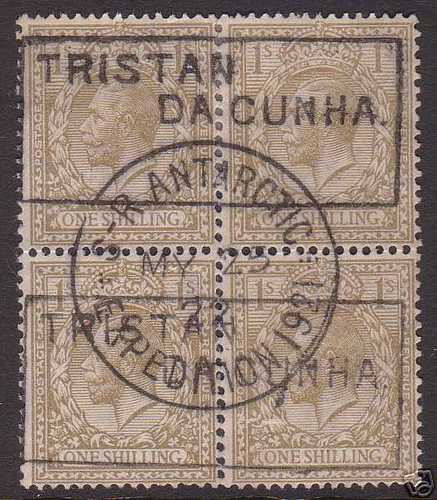
blocco di 4 con annullo di Tristan da Cunha
Ecco la descrizione del lotto con prezzo base 600 dollari:
Special
local handstamp overprint "TRISTAN DA CUNHA" of the 1922 Shackleton -
Rowett Antarctic Expedition
on Great Britain KGV 1s BLOCK OF FOUR, with "S.-R. ANTARCTIC EXPEDITION
1921 / 25 MY 22" cds applied on the return voyage.
For this Antarctic expedition the British Post Office named Sir Shackleton an
official postal agent and supplied him with special cds postmark as well as
handstamp overprint dies for use at possible places of call being "Tristan
da Cunha", "Gough Island" & "Enderby Land".
Very rare as only 431 KGV 1s stamps used in total by the expedition of all cds
& handstamps together (and most only were with normal cds) & the number
of surviving blocks with the "TRISTAN DA CUNHA" handstamp would be
tiny !

annullo di Tristan da Cunha
Ecco la descrizione del lotto con prezzo base 150 dollari:
TRISTAN DA CUNHA 1922 Shackleton Antarctic Exped local!
Special local handstamp overprint "TRISTAN DA
CUNHA" of the 1922 Shackleton - Rowett Antarctic Expedition
on Great Britain KGV ½d marginal single, with "S.-R. ANTARCTIC EXPEDITION
1921 / 25 MY 22" cds applied on the return voyage.
For this Antarctic expedition the British Post Office named Sir Shackleton an
official postal agent and supplied him with special cds postmark as well as
handstamp overprint dies for use at possible places of call being "Tristan
da Cunha", "Gough Island" & "Enderby Land".
Very rare as only 212 KGV ½d stamps used in total by the expedition of all cds
& handstamps together (and most only were with normal cds) & the number
of items with the full "TRISTAN DA CUNHA" handstamp would be tiny !
with photo-certificate

annullo di Gough island
Ecco la descrizione del lotto con prezzo base 700 dollari:
Special
local handstamp overprint "GOUGH ISLAND" of the 1922 Shackleton -
Rowett Antarctic Expedition
on Great Britain KGV 6d BLOCK OF FOUR, with "S.-R. ANTARCTIC EXPEDITION
1921 / 25 MY 22" cds applied on the return voyage.
For this Antarctic expedition the British Post Office named Sir Shackleton an
official postal agent and supplied him with special cds postmark as well as
handstamp overprint dies for use at possible places of call being "Tristan
da Cunha", "Gough Island" & "Enderby Land".
Very rare as only 326 KGV 6d stamps used in total by the expedition of all cds
& handstamps together (and most only were with normal cds) & the number
of surviving blocks with the "GOUGH ISLAND" handstamp overprint would
be extremely tiny !
Questo è il lotto più bello e raro, prezzo base 1.000 dollari:

unico esemplare da 1 penny esistente con annullo di Enderby land
Ecco la descrizione del lotto:
Special
local handstamp overprint "ENDERBY LAND" of the 1922 Shackleton -
Rowett Antarctic Expedition
on Great Britain KGV 1d, with "S.-R. ANTARCTIC EXPEDITION 1921 / 8 SP
21" cds applied before start of expedition voyage.
For this Antarctic expedition the British Post Office named Sir Shackleton an
official postal agent and supplied him with special cds postmark as well as
handstamp overprint dies for use at possible places of call being "Tristan
da Cunha", "Gough Island" & "Enderby Land".
Great rarity as the expedition never reached Enderby Land, and this handstamp
was not used any further apart from few strikes made before the start of the
voyage.
THIS IS THE ONLY EXAMPLE ON THE 1d STAMP RECORDED !!!
Non sono in grado di commentare l'autenticità o meno degli annulli. Il Vendor dice che i suoi lotti sono garantiti con foto ceretificato. I feed back positivi che ha sono oltre 2.000
Continuiamo con i nostri QUIZ:
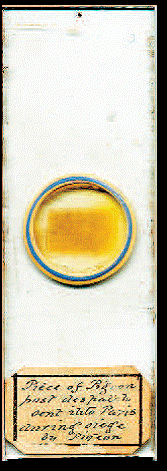
lotto 13

lotto 14
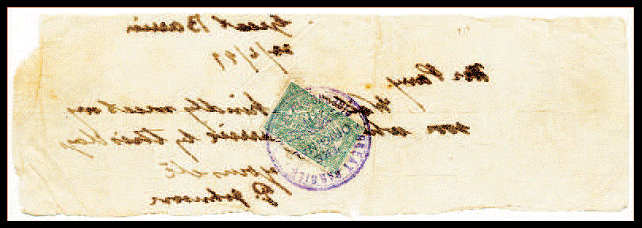
lotto 15

lotto 16

lotto 17

lotto 18
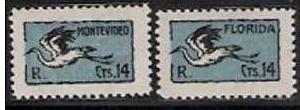
dettaglio di due LOCALS, uno è sulla cover

lotto 19
------------------- °°°°°°°°°°°°°° --------------------
Mi
scuso per eventuali imprecisioni, infatti, per risparmiare tempo,
mi sono affidato solo alla mia memoria. Per certo posso fornire le fonti -
sicuramente più attendibili di me - da cui ho tratto le varie informazioni.
Se volete approfondire i vari argomenti, contattatemi. P.S.
Su questo sito potete vedere immagini, articoli e approfondimenti
ai temi discussi nei miei messaggi per il forum Filatelia e Francobolli.
Chi
fosse interessato ai bolli della seconda guerra mondiale, a quelli dei
prigionieri di guerra o di propaganda psicologica, alla resistenza, nonché
alla storia contemporanea, incluse le missioni di pace italiane nel mondo e
quelle scientifiche al polo sud, può visitare le oltre 500 pagine, in italiano
ed in inglese, del sito, cliccando semplicemente sul tasto
"Iniziale" qui sotto. Gli
altri tasti aiutano la navigazione all'interno di questa sezione "le
storie dietro i francobolli" e "Curiosità filateliche". Precisamente:
il sommario riporta gli argomenti trattati in ogni pagina; i tasti dall' 1 al 96
aiutano ad accedere direttamente alle prime xx pagine (12 per volta) ed infine
c'è il link alla corrispondente pagina/pagine del Forum di F&F in cui
lo stesso "topic" è stato discusso. ![]() NOVITA': Se cercate uno specifico argomento ed il Sommario
non è esauriente, potete provare con il nostro motore di ricerca. Esso funziona
all'interno del sito, e può essere utilissimo. Basta scrivere la
parola che si cerca, nel rettangolo qui sotto e cliccare a destra su "find".
La ricerca può essere
fatta con una singola parola, con più parole ed anche con un * alla fine di una
parola se si vuole interrogare sia il singolare che il plurale di una parola.
Per esempio facendo la ricerca con la parola mission*
si cercano tutte le pagine del sito, che contengono le seguenti parole:
missione, missioni ed anche mission, e missions, etc. NOVITA'
NOVITA': Se cercate uno specifico argomento ed il Sommario
non è esauriente, potete provare con il nostro motore di ricerca. Esso funziona
all'interno del sito, e può essere utilissimo. Basta scrivere la
parola che si cerca, nel rettangolo qui sotto e cliccare a destra su "find".
La ricerca può essere
fatta con una singola parola, con più parole ed anche con un * alla fine di una
parola se si vuole interrogare sia il singolare che il plurale di una parola.
Per esempio facendo la ricerca con la parola mission*
si cercano tutte le pagine del sito, che contengono le seguenti parole:
missione, missioni ed anche mission, e missions, etc. NOVITA'
![]() QUI LA SEARCH ENGINE per ricerche all'interno di tutto il sito:
QUI LA SEARCH ENGINE per ricerche all'interno di tutto il sito:
 |
 |
|
|